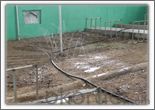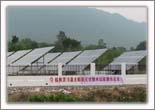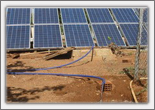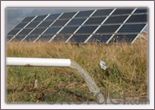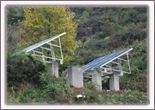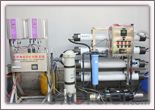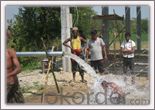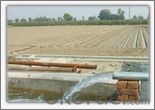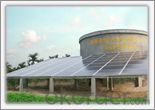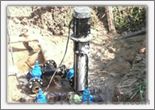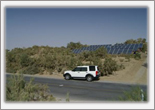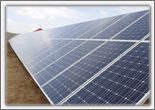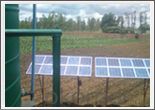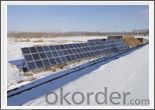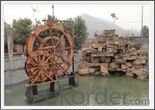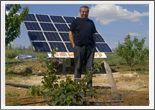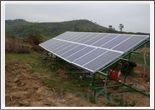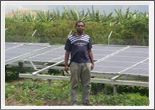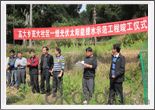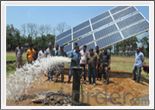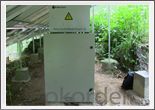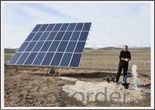Solar Pumping Inverter for Solar Water Pumping System
- Loading Port:
- Shekou
- Payment Terms:
- TT or LC
- Min Order Qty:
- 20 unit
- Supply Capability:
- 800000 unit/month
OKorder Service Pledge
OKorder Financial Service
You Might Also Like
Products
Solar Inverter Introduction:
Solar pumping inverter converts DC current from the solar array into AC current to drive the pump. With the function of MPPT (maximum power point tracking), it regulates the output frequency according to irradiation in real time to achieve the maximum power.
Solar Inverters Features:
1. Adopting the proposed dynamic VI maximum power point tracking (MPPT) control method; Fast response and stable operation; Better than the conventional methods which may lead to the problems including poor tracking performances, unstable or even cause water hammer damaging when the irradiation on the array changes rapidly.
2. The solar pumping inverters system is dispensed with energy storing devices, and stores water instead of electricity. It improves the reliability of the device, at the same time, it lowers the construction and maintenance costs of the system dramatically.
3. Digital control; automatic operation and data acquisition/storage of 8 years, etc; 98% of conversion efficiency, and complete protection.
4. In-line blocks; user friendly; convenient for operating; perfect cooling and shielding.
Technical Features
Solar Pumping Inverter Advantages:
1. To drive pumps equipped with 3-phase induction motors.
2. Optimized SPWM.
3. Various operation modes and MPPT algorithms are available.
4. Adjustable speed range of pump based on the actual situation of the system.
5. Available option of water-level detecting and control circuit.
6. Protection functions: lightning, over/low input voltage, over current and over load protection, etc.
7. Enclosure class: IP52.
8. Ambient temperature:-10~+50˚C.
Poduct Specifications
Model | Maximum input dc voltage | Recommended MPP Voltage | Rated Output Current | Output Voltage | Output Frequency | Net Weight | Gross Weight | Package Size | ||
Length | Width | Height | ||||||||
PB400L | 450 | 280-350 | 3 | 3PH 220V | 0-50 | 3.4 | 4.9 | 320 | 280 | 225 |
PB750L | 450 | 280-350 | 5 | 3PH 220V | 0-50 | 3.4 | 4.9 | 320 | 280 | 225 |
PF750L | 450 | 150-350 | 5 | 3PH 220V | 0-60 | 6.1 | 7.1 | 425 | 325 | 250 |
PB1500L | 450 | 280-350 | 7 | 3PH 220V | 0-50 | 4.0 | 5.6 | 355 | 280 | 225 |
PF1500L | 450 | 150-350 | 7 | 3PH 220V | 0-60 | 7.5 | 8.5 | 425 | 325 | 285 |
PB2200L | 450 | 280-350 | 11 | 3PH 220V | 0-50 | 4.0 | 5.6 | 355 | 280 | 225 |
PF2200L | 450 | 150-350 | 11 | 3PH 220V | 0-60 | 7.9 | 9.0 | 425 | 325 | 285 |
PB3700LA | 450 | 280-350 | 17 | 3PH 220V | 0-50 | 7.2 | 9.5 | 425 | 325 | 285 |
PB5500LA | 450 | 280-350 | 25 | 3PH 220V | 0-50 | 7.3 | 9.6 | 425 | 325 | 285 |
PB3700H | 750 | 500-600 | 9 | 3PH 380V | 0-50 | 7.2 | 9.5 | 425 | 325 | 285 |
PB5500H | 750 | 500-600 | 13 | 3PH 380V | 0-50 | 7.3 | 9.6 | 425 | 325 | 285 |
PB7500H | 750 | 500-600 | 18 | 3PH 380V | 0-50 | 7.7 | 10 | 425 | 325 | 285 |
PB11KH | 750 | 500-600 | 24 | 3PH 380V | 0-50 | 8.2 | 10.5 | 425 | 325 | 285 |
PB15KH | 750 | 500-600 | 30 | 3PH 380V | 0-50 | 8.4 | 10.7 | 425 | 325 | 285 |
PB18KH | 750 | 500-600 | 39 | 3PH 380V | 0-50 | 8.4 | 10.7 | 425 | 325 | 285 |
PB22KH | 750 | 500-600 | 45 | 3PH 380V | 0-50 | 18 | 21 | 600 | 465 | 350 |
PB30KH | 750 | 500-600 | 60 | 3PH 380V | 0-50 | 18 | 21 | 600 | 465 | 350 |
PB37KH | 750 | 500-600 | 75 | 3PH 380V | 0-50 | 20 | 23 | 600 | 465 | 350 |
PB45KH | 750 | 500-600 | 91 | 3PH 380V | 0-50 | 20 | 23 | 600 | 465 | 350 |
PB55KH | 750 | 500-600 | 112 | 3PH 380V | 0-50 | 20 | 23 | 600 | 465 | 350 |
Success Stories
►Middle East ►NaQu ►GuiLin
►Turkey ►XiNing ►YunNan
►Army stationed island ►Bangladesh ►Pakistan
►HaiNan ►HuBei ►Uganda
►XinJiang ►NingXia ►Afghan
►Zimbabwe ►Inner Mongolia ►Zhejiang
►Guangxi Guilin ►Turkey2 ►Botswana
►Naning ►Uganda ►Shaanxi
►Tsinghua University ►Pakistan ►Yunnan2
►FuJian ►Banqladesh ►YunNan3
►Turkey ►Inner Mongolia ►Senegal
- Q:What is the impact of air pollution on the performance of solar panels?
- Solar panel performance can be significantly affected by air pollution. One of the main ways in which it affects them is by diminishing the amount of sunlight that reaches the panels. Sunlight can be scattered and absorbed by air pollution, such as smog and particulate matter, resulting in a decrease in the solar energy absorbed by the panels. This, in turn, reduces the overall efficiency and power output of the panels. Furthermore, a layer of dust, dirt, and other pollutants can be deposited on the surface of solar panels due to air pollution. This layer obstructs and absorbs sunlight, further reducing the amount of energy that can be collected. Additionally, the accumulation of these pollutants acts as a barrier that hampers the transmission of sunlight to the solar cells, thus decreasing the panels' efficiency. Moreover, air pollution can cause the corrosion of solar panel surfaces. Pollutants like sulfur dioxide and nitrogen oxides can react with moisture in the air, forming acidic compounds. Over time, these compounds gradually deteriorate the protective coatings on the panels and damage the cells, leading to a reduction in performance and lifespan. Overall, the impact of air pollution on solar panels is significant. It diminishes the amount of harvested sunlight, lowers the efficiency and power output of the panels, and can cause damage and deterioration over time. Therefore, it is crucial to consider the effects of air pollution during the design and installation of solar panels to ensure optimal performance and longevity.
- Q:Can solar energy systems be used for water purification?
- Yes, solar energy systems can be used for water purification. Solar-powered water purification systems use sunlight to generate heat or electricity, which is then used to treat water by eliminating contaminants, such as bacteria, viruses, and chemicals. These systems are eco-friendly, cost-effective, and can be particularly useful in remote areas where access to clean water is limited.
- Q:Can solar energy systems be integrated into building materials, such as solar roof tiles?
- Yes, solar energy systems can be integrated into building materials, and one popular example is solar roof tiles. Solar roof tiles, also known as solar shingles or solar slates, are designed to resemble traditional roofing materials while harnessing solar energy. These specially designed tiles are made of photovoltaic cells that convert sunlight into electricity. Solar roof tiles have several advantages over traditional solar panels. Firstly, they blend seamlessly with the overall appearance of the building, making them more aesthetically pleasing. This integration into the building's structure allows for a more cohesive design, especially in areas where strict architectural guidelines are in place. Additionally, solar roof tiles can be installed on both new and existing buildings, providing a flexible and adaptable solution. Another advantage of solar roof tiles is their ability to generate electricity while being durable and weather-resistant. These tiles are made to withstand various weather conditions, including rain, snow, and wind. Furthermore, solar roof tiles are typically made from high-quality materials, ensuring a longer lifespan compared to traditional roofing materials. The integration of solar energy systems into building materials like solar roof tiles offers numerous benefits. They not only generate clean and renewable energy but also contribute to reducing the reliance on fossil fuels and decreasing carbon emissions. Additionally, solar roof tiles can help reduce energy costs by generating electricity on-site, allowing homeowners and businesses to become more energy-independent. Overall, solar energy systems can indeed be integrated into building materials, and solar roof tiles are a prime example of this. With their aesthetic appeal, durability, and energy-generating capabilities, solar roof tiles are a promising solution for harnessing solar energy while maintaining the architectural integrity of a building.
- Q:Can solar energy systems be used for powering electric vehicle charging infrastructure?
- Yes, solar energy systems can definitely be used for powering electric vehicle (EV) charging infrastructure. Solar power is a clean and renewable energy source that can be harnessed through photovoltaic (PV) panels. These panels can be installed on rooftops, carports, or open fields, and they convert sunlight into electricity. The electricity generated by solar panels can be used to directly charge EVs or to power the EV charging infrastructure including charging stations, grid-tied DC fast chargers, or battery storage systems. By using solar power to charge electric vehicles, we can significantly reduce greenhouse gas emissions and dependency on fossil fuels. Solar-powered EV charging infrastructure offers numerous benefits. Firstly, it helps reduce the carbon footprint associated with transportation by using clean energy instead of relying on electricity from the grid, which is often generated from fossil fuel sources. Secondly, it provides an opportunity for decentralized energy production, allowing EV owners to charge their vehicles with renewable energy generated on-site. This reduces strain on the electric grid and promotes energy independence. Furthermore, solar EV charging infrastructure can be combined with energy storage systems such as batteries. This enables the storage of excess solar energy during the day and its utilization for EV charging during the night or when the sun is not shining. Battery storage can also help manage peak demand and ensure a more stable and reliable power supply for the charging infrastructure. The implementation of solar-powered EV charging infrastructure is a growing trend globally. Public and private entities are installing solar panels at charging stations, parking lots, and highways to provide sustainable and economical charging options for electric vehicle owners. Additionally, government incentives and subsidies are often available to encourage the adoption of solar energy and EVs. In conclusion, solar energy systems can be effectively used for powering electric vehicle charging infrastructure. This combination provides a sustainable and clean solution for transportation, reduces carbon emissions, and promotes energy independence.
- Q:What are the different mounting options for solar panels?
- The different mounting options for solar panels include roof mounts, ground mounts, pole mounts, and tracking mounts. Roof mounts are the most common and are installed directly on the roof of a building. Ground mounts are placed on the ground and offer flexibility in terms of positioning and tilting. Pole mounts are installed on poles or posts, suitable for areas with limited space or uneven terrain. Tracking mounts are advanced systems that move the solar panels to track the sun's position throughout the day, maximizing energy production.
- Q:Can a solar energy system be installed on a library or educational institution?
- Indeed, the installation of a solar energy system on libraries and educational institutions is possible. This approach has gained popularity among many of these establishments as an effective and eco-friendly solution to their energy requirements. By adopting solar energy, libraries and educational institutions not only cut down on electricity costs but also demonstrate their dedication to clean energy and environmental consciousness. Libraries and educational institutions often boast expansive rooftops or available open spaces that make them perfect candidates for solar panel installation. These panels can be affixed to the roof or positioned on the ground, depending on the space available and structural considerations. Moreover, solar panels can even be incorporated into building materials like windows or walls, offering aesthetically pleasing and innovative installations. By embracing solar energy, libraries and educational institutions can generate their own electricity and reduce their dependence on fossil fuels. This approach can lead to substantial long-term savings since solar energy is a renewable resource that does not require ongoing fuel expenses. Additionally, any excess electricity produced by the solar panels can be fed back into the grid, enabling libraries and educational institutions to contribute to the local energy supply and potentially receive incentives or credits from the government. Furthermore, the installation of solar panels on libraries and educational institutions can serve as a valuable educational tool. It creates an opportunity to educate students, staff, and the community about the advantages of renewable energy, energy preservation, and environmental stewardship. Schools and libraries can incorporate the solar energy system into their curriculum, offering a hands-on learning experience and engaging students in comprehending the scientific, technological, and environmental aspects of solar energy. In conclusion, libraries and educational institutions can benefit from the installation of a solar energy system, offering advantages such as cost savings, environmental sustainability, and educational opportunities. The decision to opt for solar energy aligns with the values held by these establishments and showcases their commitment to a cleaner, more sustainable future.
- Q:How do solar energy systems impact air conditioning costs?
- Solar energy systems can significantly reduce air conditioning costs by providing a renewable and cost-effective source of power. By harnessing the sun's energy to generate electricity, solar panels can power air conditioning units directly, eliminating or reducing the need for grid electricity. This can result in lower energy bills and reduced dependence on fossil fuels, leading to a more sustainable and environmentally-friendly cooling solution.
- Q:Is solar energy reliable?
- Yes, solar energy is reliable. Solar panels can generate electricity as long as they are exposed to sunlight, which is abundant and available in most regions. Additionally, solar energy systems have a lifespan of 25-30 years, and with proper maintenance, they can consistently produce power during that period. The advancements in solar technology have also made it more efficient and cost-effective, making it a reliable source of renewable energy for both residential and commercial applications.
- Q:Can solar energy systems be used for powering shopping malls or retail centers?
- Absolutely, shopping malls and retail centers can definitely utilize solar energy systems to power their operations. In fact, numerous shopping malls and retail centers worldwide have already embraced solar energy systems to meet their energy requirements. These establishments can install solar panels on their rooftops or in parking lots to capture sunlight and transform it into usable electricity. There are numerous advantages to using solar energy systems in shopping malls and retail centers. Firstly, they offer a consistent and reliable source of clean and renewable energy. This decreases reliance on fossil fuels, reduces carbon emissions, and contributes to a more sustainable future. Additionally, solar energy systems can significantly reduce energy costs for these establishments. Once the initial installation costs are covered, the electricity generated by solar panels is essentially free. Furthermore, solar panels can be seamlessly integrated into the architectural design of shopping malls and retail centers, providing a visually appealing and distinctive feature. This can enhance the overall aesthetic appeal of the buildings and attract more customers. Additionally, solar panels can provide shade in parking lots, protecting vehicles from direct sunlight and minimizing the need for air conditioning. However, it is important to consider various factors such as available space, local regulations, and financial considerations when determining the feasibility of installing solar energy systems in shopping malls or retail centers. Effective planning and design are crucial to ensure optimal utilization of solar energy and maximize the associated benefits. All in all, solar energy systems offer a practical and sustainable solution for powering shopping malls and retail centers. Their adoption not only reduces environmental impact but also provides long-term cost savings and promotes a positive brand image for businesses.
- Q:Can solar energy systems be used in areas with low sunlight?
- Yes, solar energy systems can still be used in areas with low sunlight. While solar panels are most effective in areas with abundant sunlight, advancements in solar technology have made it possible to generate electricity even in areas with lower sunlight levels. Additionally, solar energy systems can still provide a reliable source of energy in such areas by utilizing battery storage to store excess energy generated during periods of higher sunlight and using it during times of lower sunlight.
1. Manufacturer Overview |
|
|---|---|
| Location | |
| Year Established | |
| Annual Output Value | |
| Main Markets | |
| Company Certifications | |
2. Manufacturer Certificates |
|
|---|---|
| a) Certification Name | |
| Range | |
| Reference | |
| Validity Period | |
3. Manufacturer Capability |
|
|---|---|
| a)Trade Capacity | |
| Nearest Port | |
| Export Percentage | |
| No.of Employees in Trade Department | |
| Language Spoken: | |
| b)Factory Information | |
| Factory Size: | |
| No. of Production Lines | |
| Contract Manufacturing | |
| Product Price Range | |
Send your message to us
Solar Pumping Inverter for Solar Water Pumping System
- Loading Port:
- Shekou
- Payment Terms:
- TT or LC
- Min Order Qty:
- 20 unit
- Supply Capability:
- 800000 unit/month
OKorder Service Pledge
OKorder Financial Service
Similar products
New products
Hot products
Hot Searches
Related keywords
















